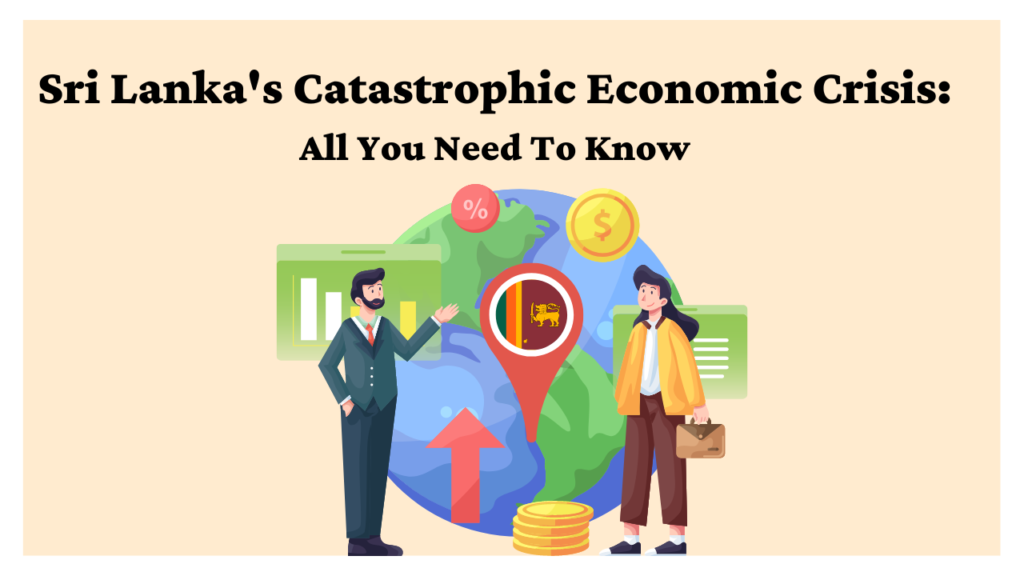
INTRODUCTION
The island nation of Sri Lanka is currently experiencing an economic crisis of epic proportions that may be traced back to 2019. Since gaining independence in 1948, this is the nation’s biggest economic catastrophe. It has resulted in previously levels inflation unheard-of, a nearly complete depletion of foreign exchange reserves, a lack of medical supplies, and a spike in the cost of essential necessities. According to reports, a number of interconnected reasons, including tax reductions, money creation, a national initiative to switch to organic or biological farming, the 2019 Easter bombings in Sri Lanka, and the COVID-19 pandemic’s effects in Sri Lanka, are factors that contributed to the crisis. The Sri Lankan protests in 2022 were brought on by the ensuing economic woes.
In light of the fact that Sri Lanka’s residual foreign exchange reserves, which stood at US$1.9 billion as of March 2022, would not be sufficient to cover its $4 billion in 2022 foreign debt payments, the government has been flagged for sovereign default. The government is required to repay a $1 billion International Sovereign Bond in July 2022. According to Bloomberg, Sri Lanka owes both local and foreign creditors a combined $8.6 billion in repayments that are due in 2022. The Sri Lankan government announced its default in April 2022, marking the country’s first sovereign default since gaining independence in 1948 and the first in the Asia-Pacific region in the twenty-first century. Former Prime Minister Ranil Wickremesinghe declared in front of the parliament in June 2022 that the economy had collapsed, leaving it unable to pay for essentials[1].
WHAT PRECIPITATED THE CRISIS IN SRI LANKA?
There was no single specific cause, event, or incident that triggered this. The economic crisis that Sri Lanka is currently experiencing was caused by a number of factors. Let’s learn today about each of those causes.
External Debts Of Sri Lanka :
The cultivation of rubber, tea, and coconuts was extensive in Sri Lanka between 1948 and 1955. Therefore, the majority of it was exported. 90% of Sri Lanka’s exports consisted of them. Diversification was attempted but failed. The prices of tea and rubber fell sharply in price on the world market in 1955, and both the export earnings and prices fell significantly. The nation’s first foreign reserve problem occurred in this instance[2].
The government’s revenue in 1977 was insufficient to pay for the welfare programmes it had pledged to appease the people. In order to pay them off, the government took out loans. Currently, debt repayment consumes 83% of the Sri Lankan government’s income. A report from CNBCTV18 states that in 2021, the nation accumulated a $35 billion foreign debt. Up until this point, the IMF had helped Sri Lanka 16 times. Let’s hoping the seventeenth time is the charm.
Promises Of The President :
During his campaign for president, Gotabaya Rajapaksa, the president of Sri Lanka, pledged to decrease the value-added tax in half. Since lower taxes would stimulate more spending, the goal was to increase consumption among the populace. When he won, he backed up his words with his own money or the money of the nation. However, the time was unfortunate. Covid occurred about three months after this was put into action. Lockdown was in effect, and some people started losing their jobs. This defeated the justification for higher consumption, and the reverse resulted. The government suffered a significant loss in revenue as a result of the tax reduction[3].
The Sri Lankan Tourism Sector :
Sri Lanka was a lively, prosperous nation that attracted lots of tourists and was a gracious host. Up to 2019, Sri Lanka’s GDP was 12%–13% influenced by the tourism industry. But then, on a critical day in April 2019, there were the Easter Day bombs. Sri Lankan nationals connected to a neighbourhood Islamic terrorist organisation carried these bombings. They attacked 3 churches and 3 hotels. On that terrible day, 269 people died. However, 45 of them had a foreign nationality. Now it is clear how it would have affected tourism. This resulted in widespread violence against Muslims. Tensions between religions increased. And it became apparent how risky a tour to Sri Lanka was to the unaided tourist eye.
The Sri Lankan Agricultural Crisis :
The President also declared that all agricultural production in the nation will be turned to organic farming, which forgoes the use of chemical fertilisers. Over the course of ten years, this was to be completed. However, the government abruptly outlawed all synthetic pesticides and fertilisers. This had a significant influence on production output and resulted in a 20–30% decrease in efficiency. Due to this, Sri Lankans started lacking access to food[4]. They were unable to grow in their own nation and because they have few foreign reserves, they are unable to import enough.
WHAT IS THE PRESENT SITUATION IN SRI LANKA?
Mass demonstrations against the Sri Lankan government have been going on since March 2022. The government has been criticized for mismanaging the Sri Lankan economy. The resignation of Gotabaya Rajapaksa and other important members of the Rajapaksa family has been the protesters’ principal demand. Despite the involvement of various opposition parties, the majority of protesters have regarded themselves to be apolitical, and some have voiced their discontent with the parliamentary opposition. Protesters have chanted phrases like “go home Gota” and “go home Rajapaksas” during the protests. The general people, particularly youths, have been a big contributor to the protests. In response to these demonstrations, the government has taken authoritarian measures, including a state of emergency, permitting the military to detain citizens, enforcing curfews, and limiting access to social media. By seeking to put an end to the protests, the government has violated both the law and the Sri Lankan constitution. Demonstrations against the country’s violation of fundamental human rights have also started among Sri Lanka’s diaspora. The government’s social media ban was seen as having failed in April, as hashtags like GoHomeGota and GoGotaGo became popular on Twitter in nations like the United States, Singapore, and Germany. On April 3, the protests led to the resignation of a number of officials and ministers, including Rajapaksa family members and their close associates. Additionally, more qualified and experienced officials were appointed, and the Advisory Group on Multilateral Engagement and Debt Sustainability was established[5]. In July 2022, protesters seized control of President’s House in Colombo, forcing Rajapaksa to escape and prompting Ranil Wickremesinghe, the prime minister, to declare his own willingness to resign immediately. A week later, on July 20, Parliament elected Wickremesinghe to serve as president.
WHAT CAN BE DONE TO REMEDY THE SITUATION?
The Growth Of Agricultural Production :
Increased agricultural production would not have been a major concern had it not been for President Gotobaya Rajapaksa’s foolish plan to switch to organic farming in 2019. This plan lacked a solid transition plan. All farmers in the nation were required to use organic fertiliser as part of the plan, which called for a 10-year phase-out of all synthetic fertilisers. This decision spelled calamity for a nation that depends as largely on its agro-business as it does on its pandemic-devastated tourism industry. The government should reverse its manure policy and make investments in fertilisers that are environmentally friendly, or at the very least less harmful, in order to address this issue.
Productive Labour As Well As Greater Access To Public Services And Education Across The Nation :
The nation must create and implement a pro-labor welfare programme. Productivity is atrociously low due to the irregular hours and low pay in the informal labour sector. Productivity would rise along with a strong system that the government would use to monitor the health, welfare, and education of its workforce. More state-funded educational institutions must be established in the nation as well, enabling more Sri Lankans to use their abilities to better industrialise the agriculture and tourism sectors.
More Employment Opportunities In Industries Other Than Agriculture :
The Covid-19 outbreak was a death knell for economic growth in Sri Lanka, a country that is heavily dependent on tourism and where the industry is the third-largest market in the nation. The financing for projects to build new infrastructure in the hotel sector was reduced as a result of declining foreign tourism. Foreign aid should be used by the government to promote and grow tourism.
CONCLUSION
As a result of the current crisis, Sri Lanka is eager to implement significant financial and regulatory reforms. These changes will lessen the likelihood of a crisis in the future and will lessen its effects, making them worthy of the wider public support. The aforementioned actions should be taken by the Sri Lankan government to help the entire nation’s economy recover. With the fulfilment of the anticipated inflows from bilateral partners and future debt-free inflows, it hopes that the foreign exchange situation would quickly improve. Foreign exchange earnings from the travel and tourism sector and remittances are likely to increase soon. The people of Sri Lanka are anticipated to experience economic relief in the near future.
[1] George, A. S. H., George, A. S., & Baskar, T. (2022). Sri Lanka’s Economic Crisis: A Brief Overview. Partners Universal International Research Journal, 01(02). https://doi.org/10.5281/zenodo.6726553
[2] Sultana, G. (2022). Economic Crisis in Sri Lanka: An Assessment. Manohar Parrikar Institute for Defence Studies and Analyses. https://www.idsa.in/system/files/issuebrief/ib-economic-crisis-in-sri-lanka-gsultana-100322.pdf
[3] Kelegama, S. (2016). Global Economics Crisis and Sri Lanka. Institute of Policy Studies of Sri Lanka website: https://www.ips.lk/wp-content/uploads/2016/12/cpm.pdf
[4] Matthias, A. T., & Jayasinghe, S. (2022). Worsening economic crisis in Sri Lanka: impacts on health. Thelancet, 10. https://doi.org/https://doi.org/10.1016/ S2214-109X(22)00234-0
[5] Bhowmick, S. (2022). Understanding the Economic Issues in Sri Lanka’s Current Debacle. Observer Researcher Foundation. https://www.orfonline.org/research/understanding-the-economic-issues-in-sri-lankas/
YLCC would like to thank Dipti Tharwani for her valuable insights in this article.






